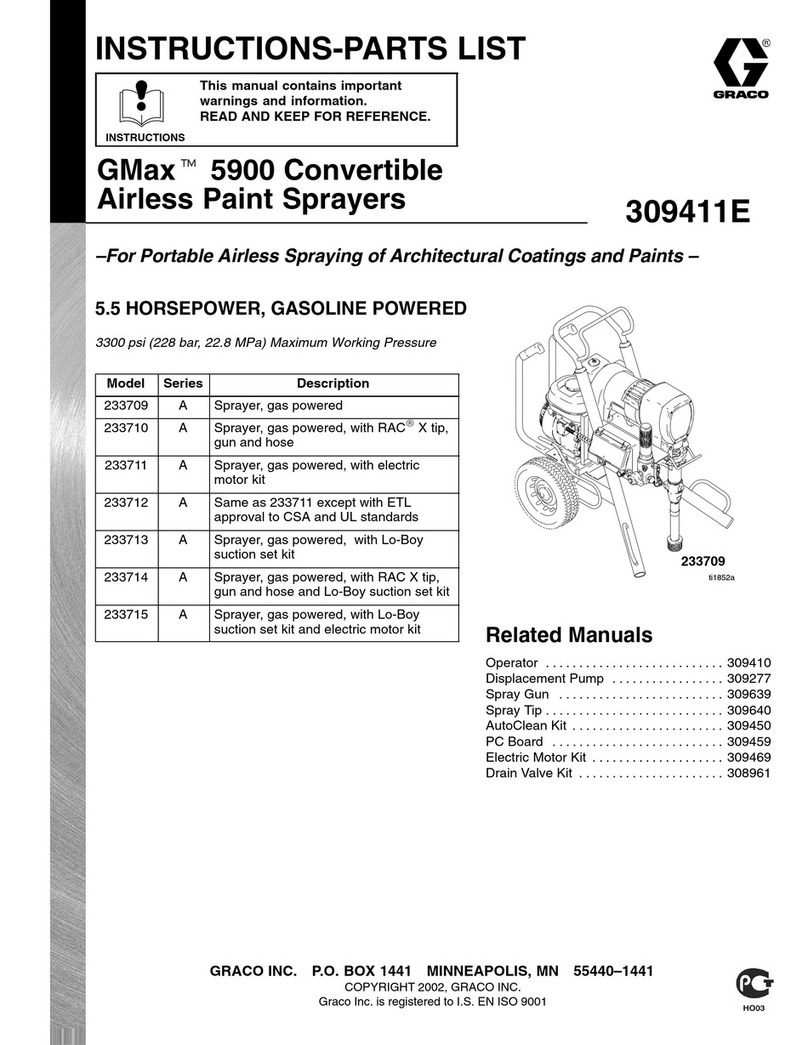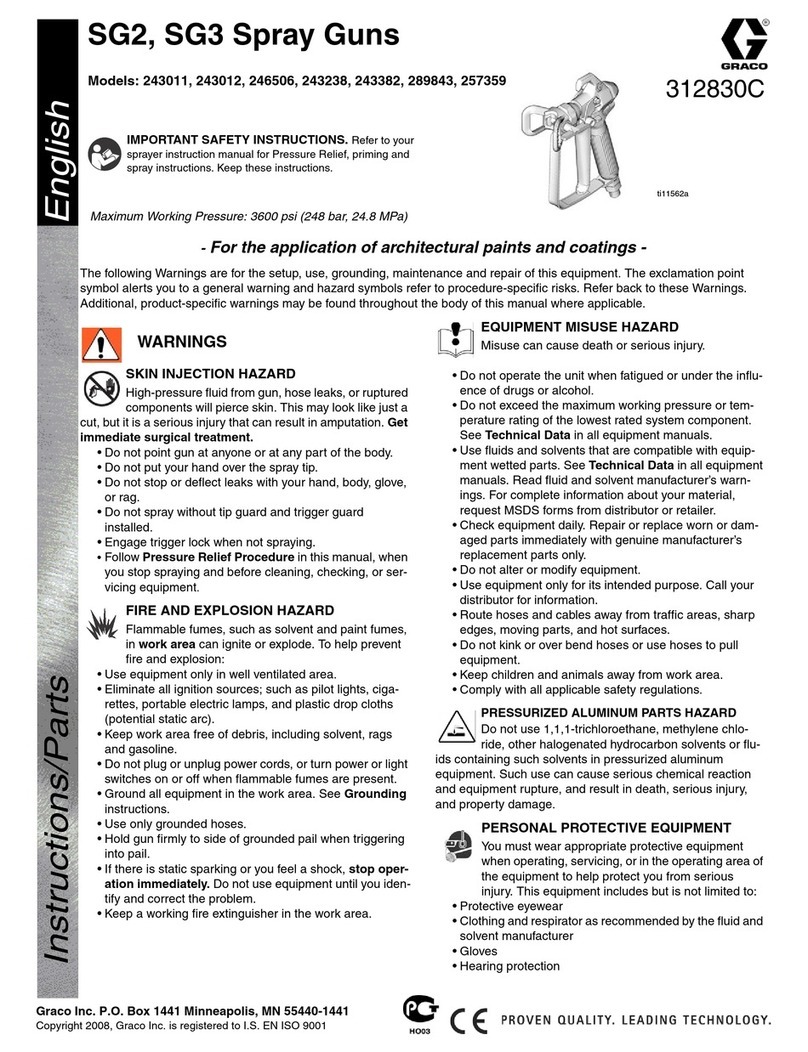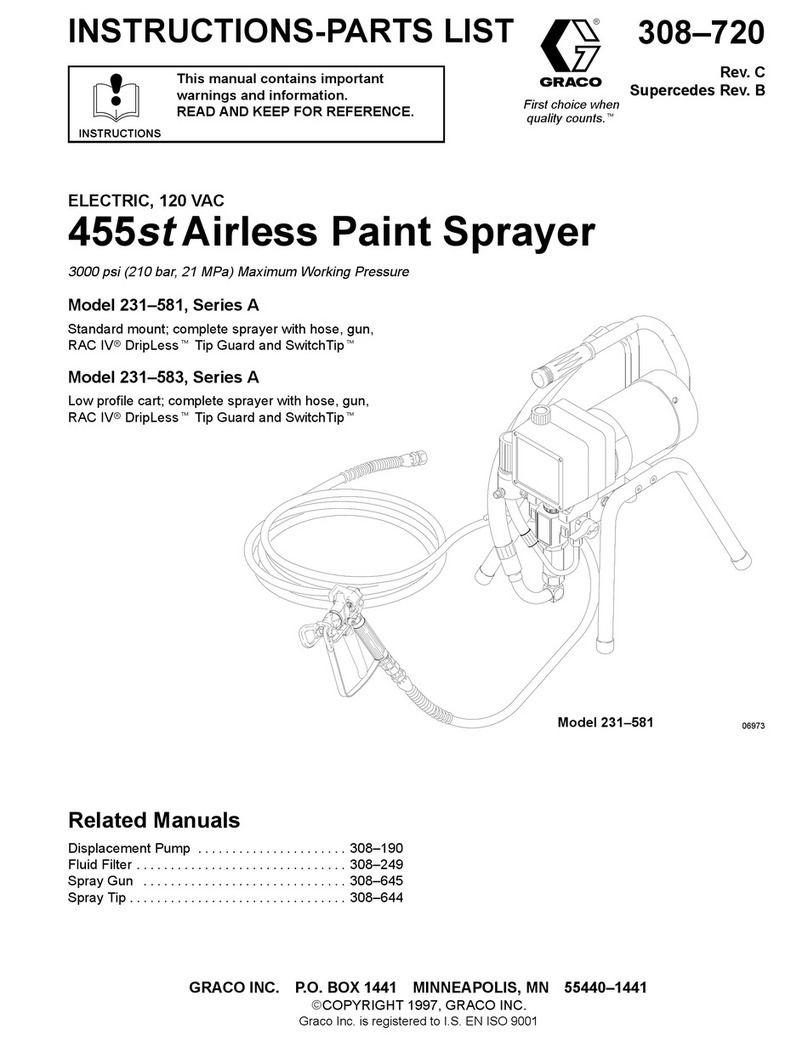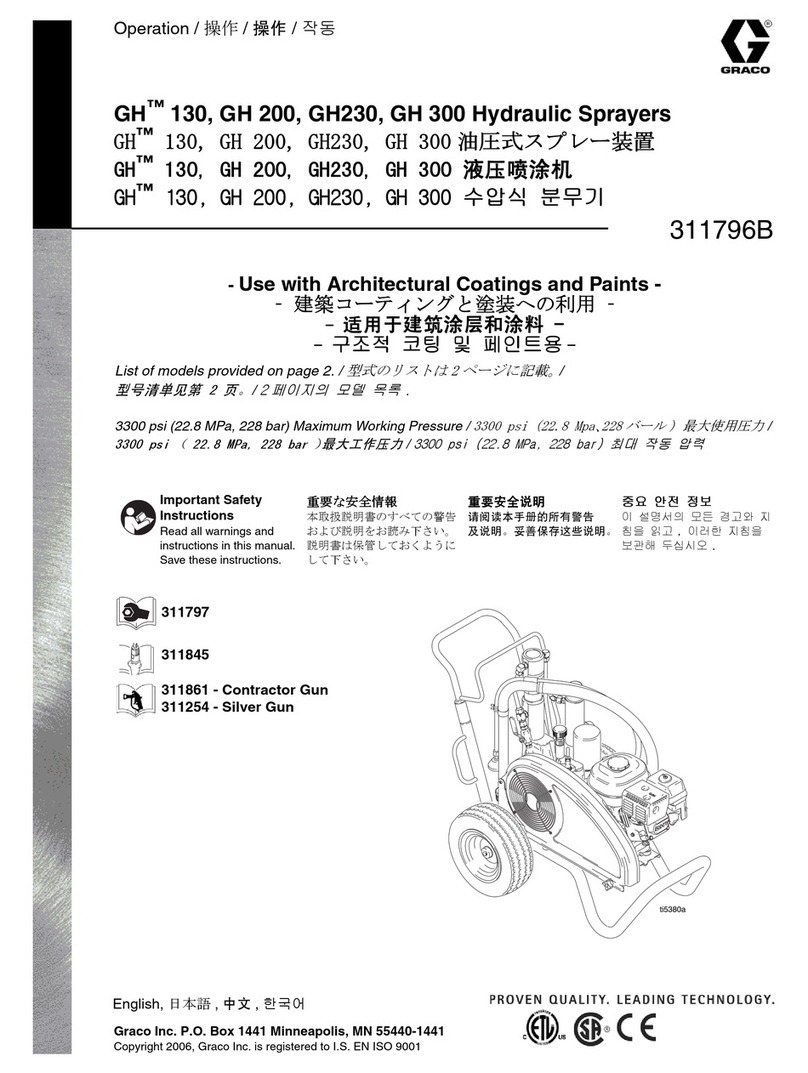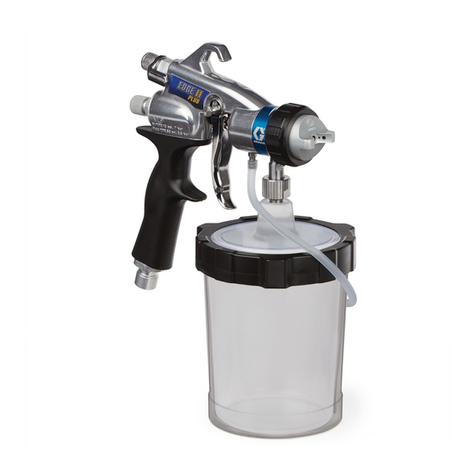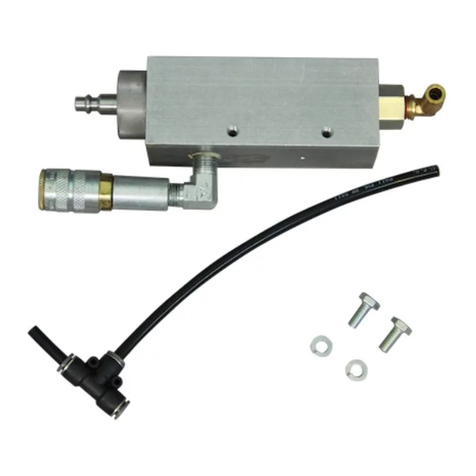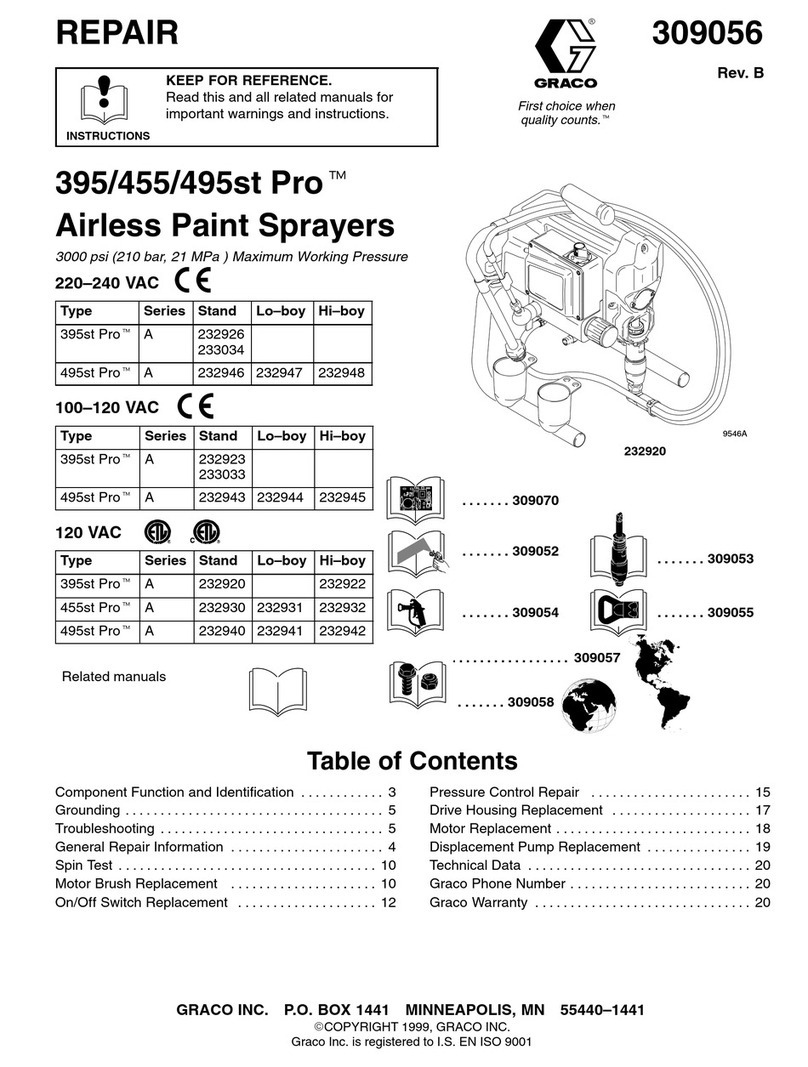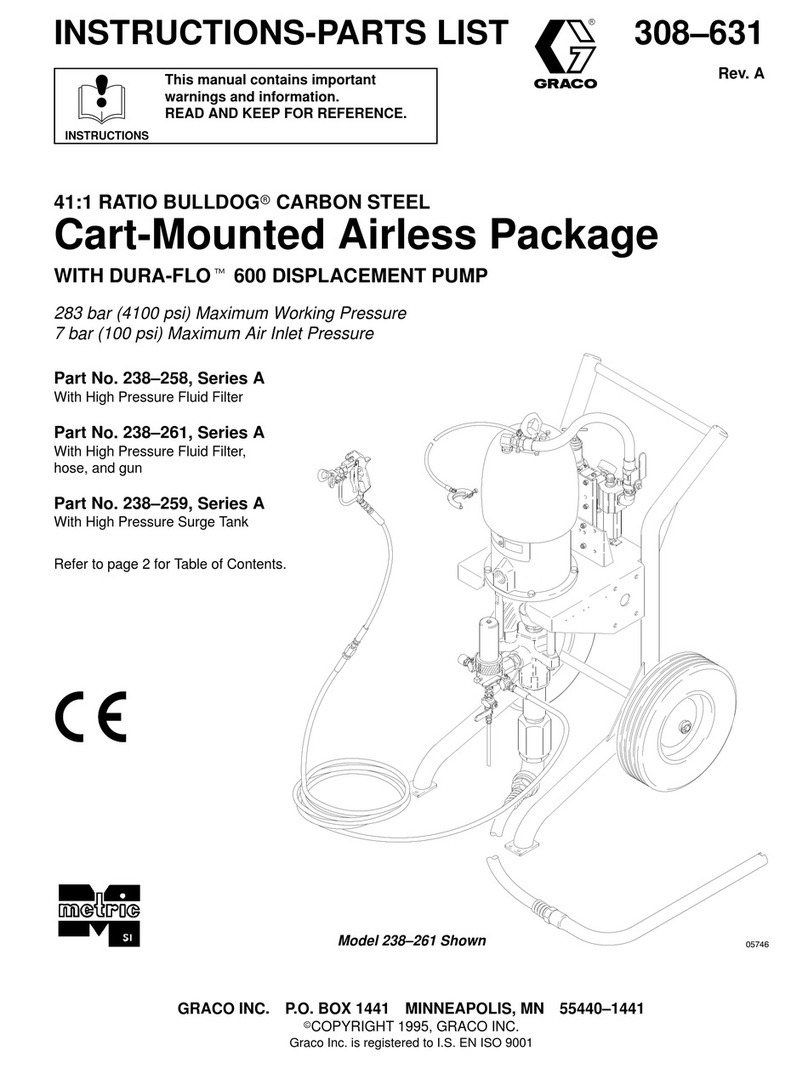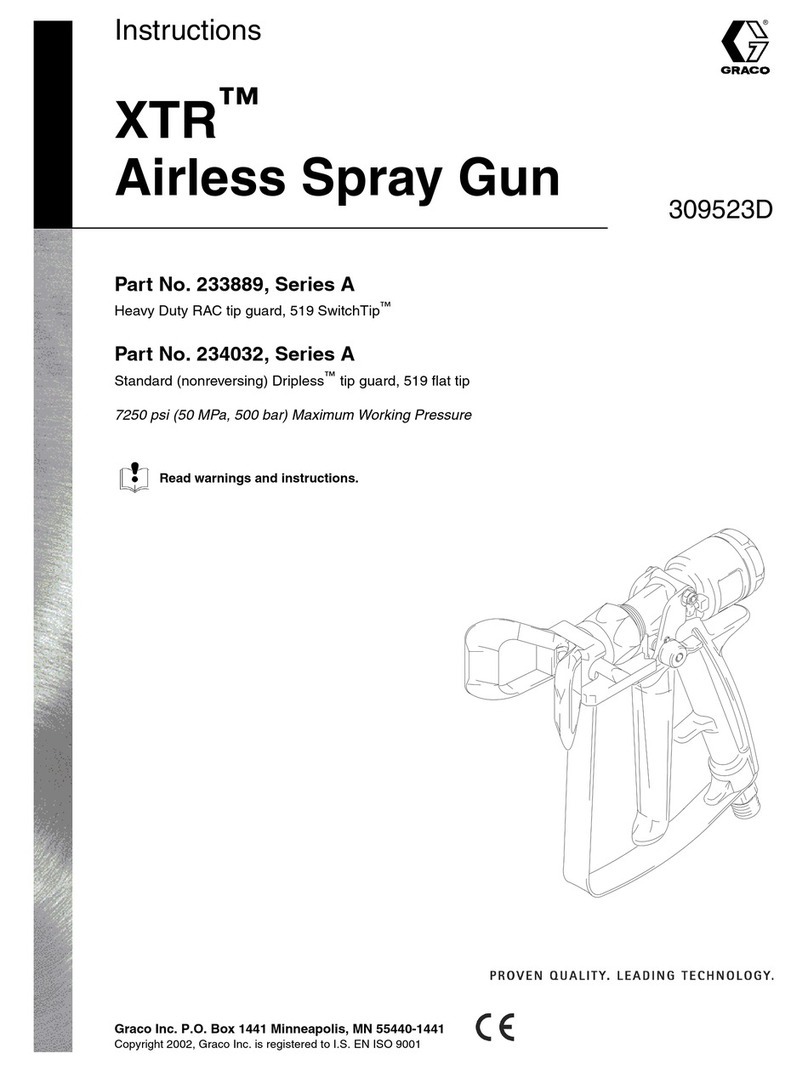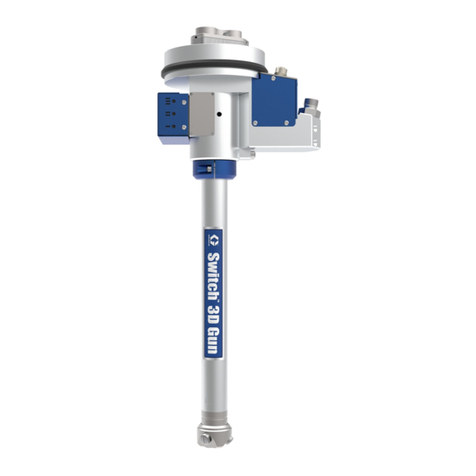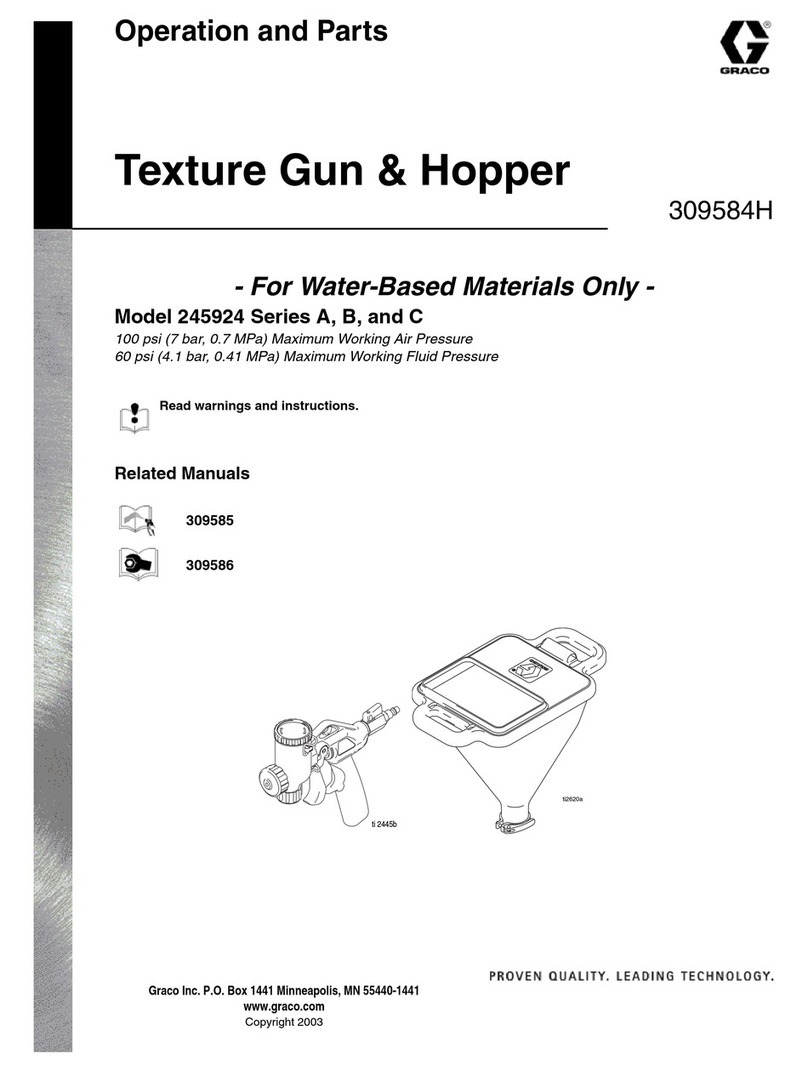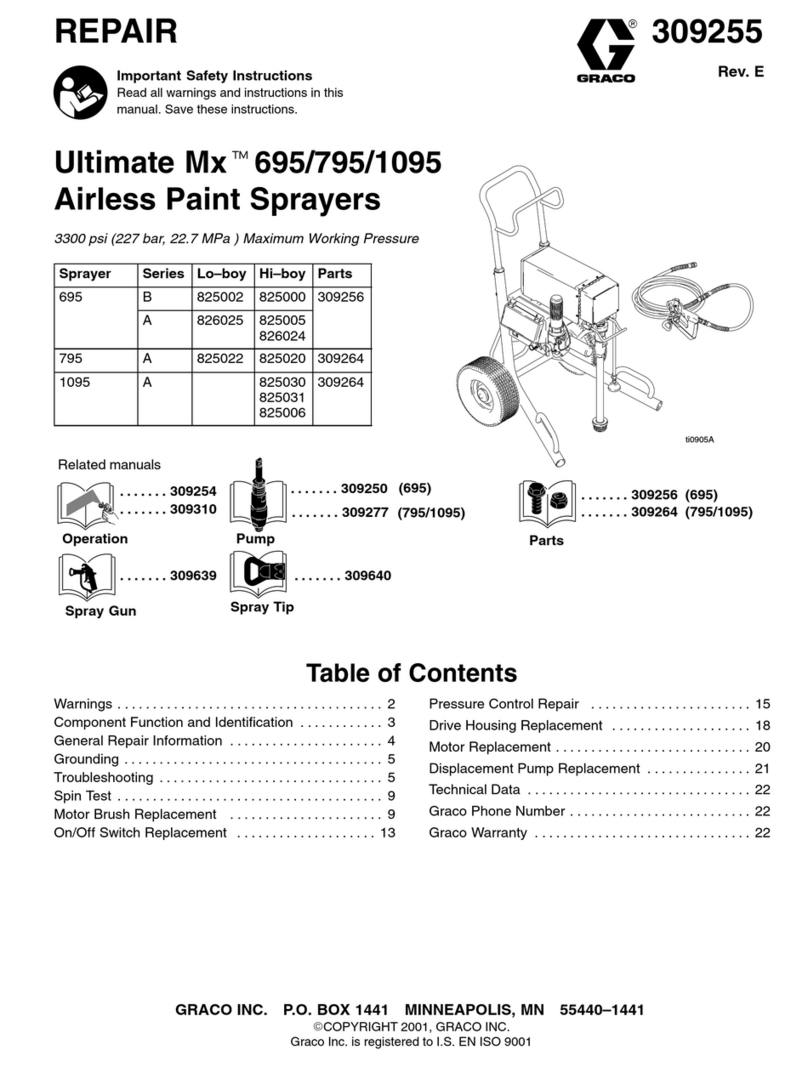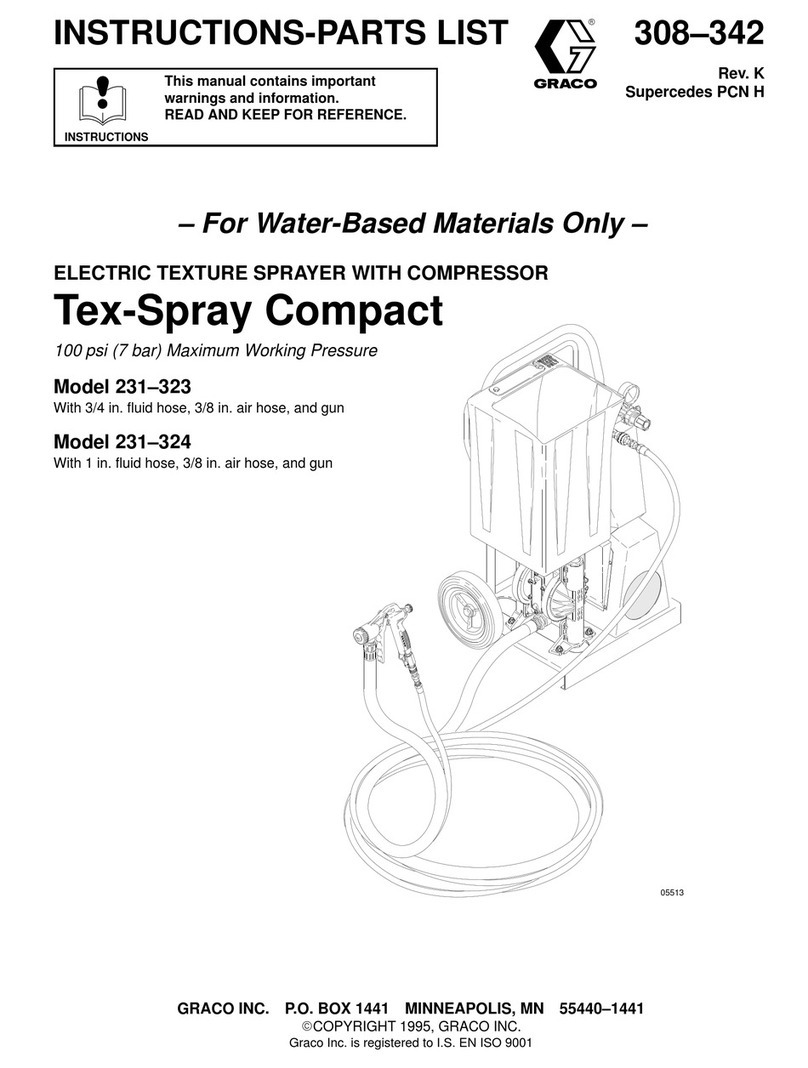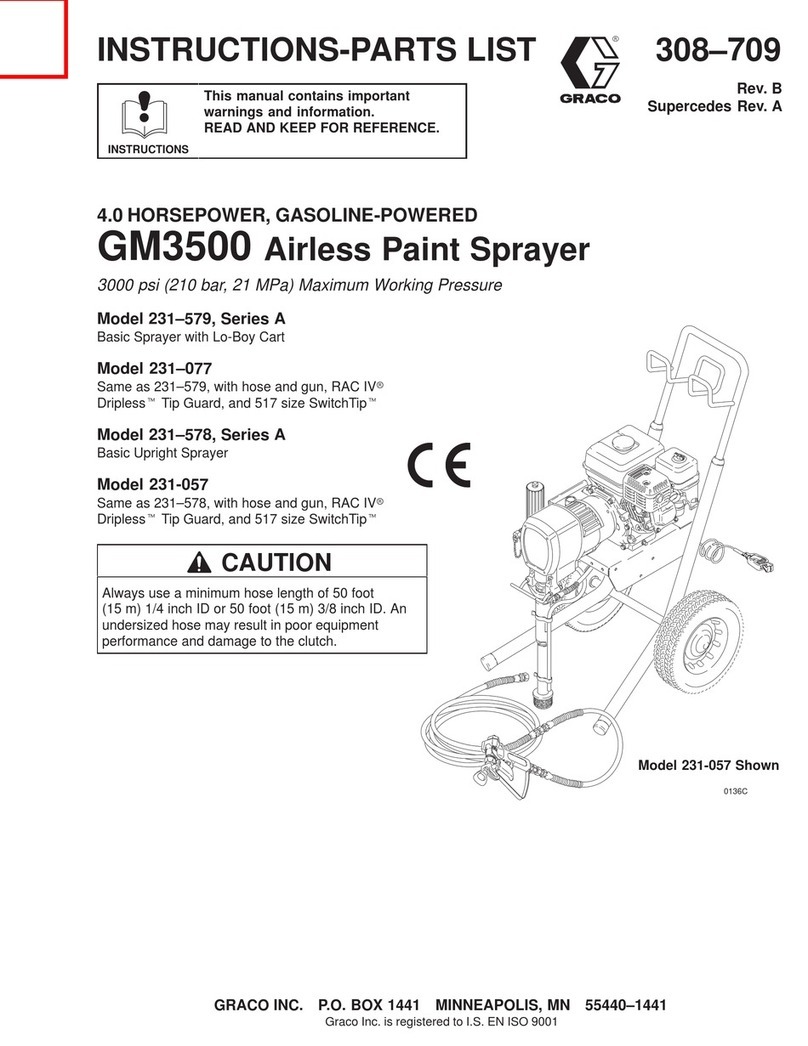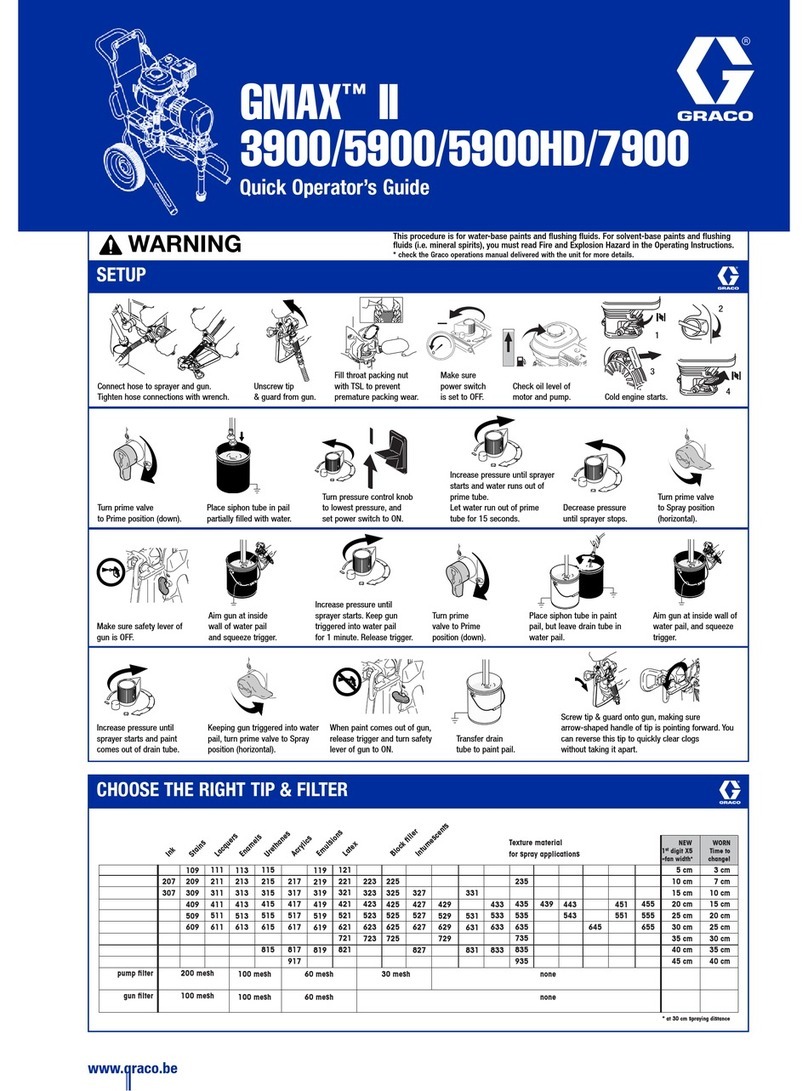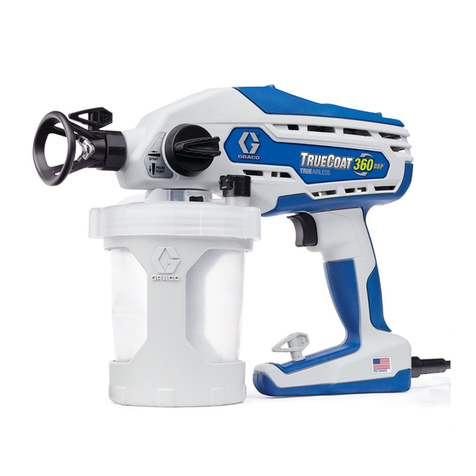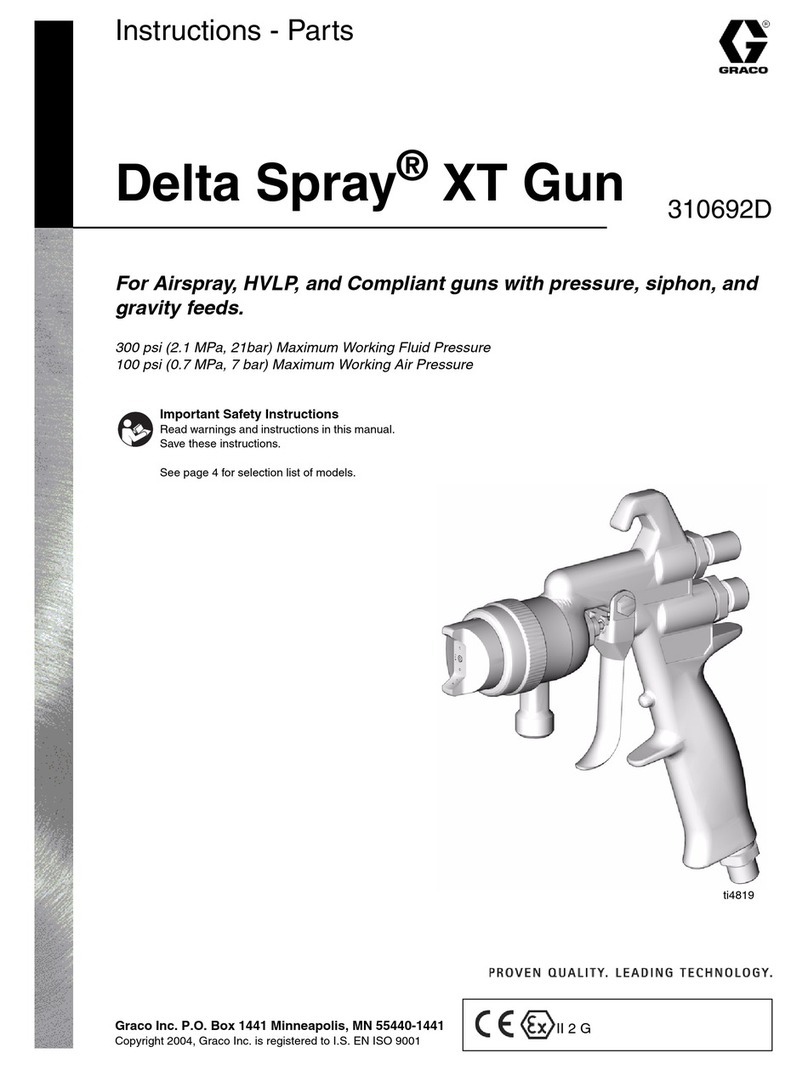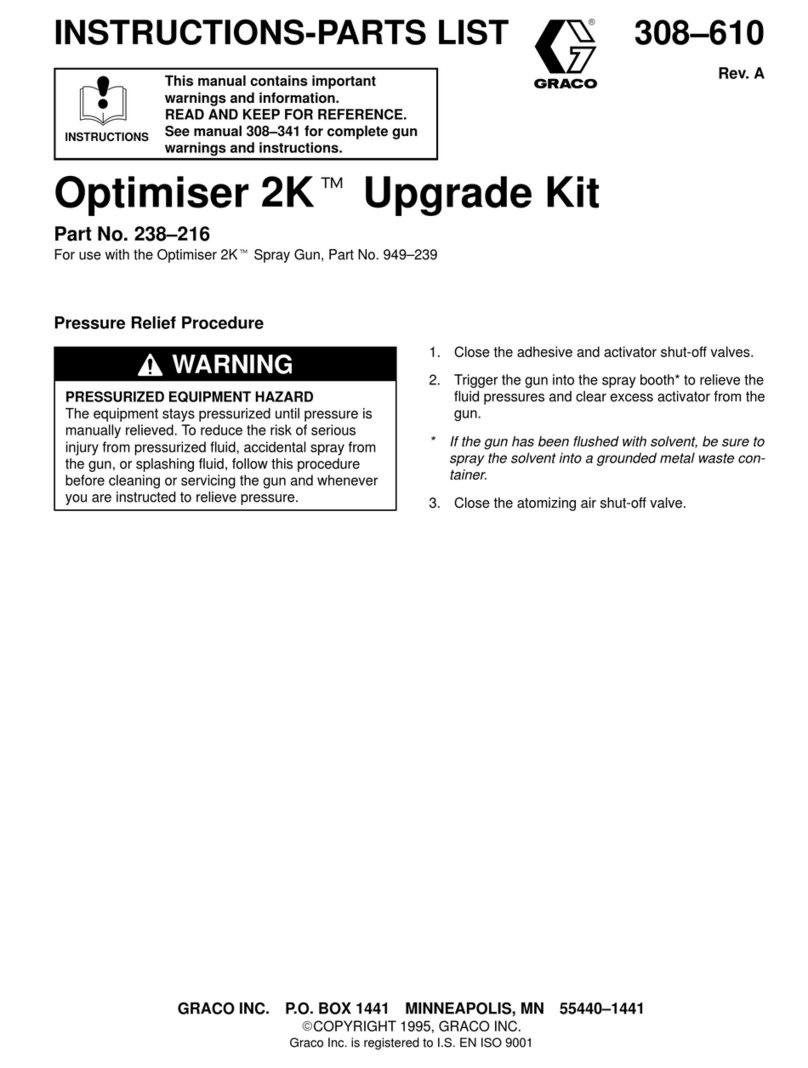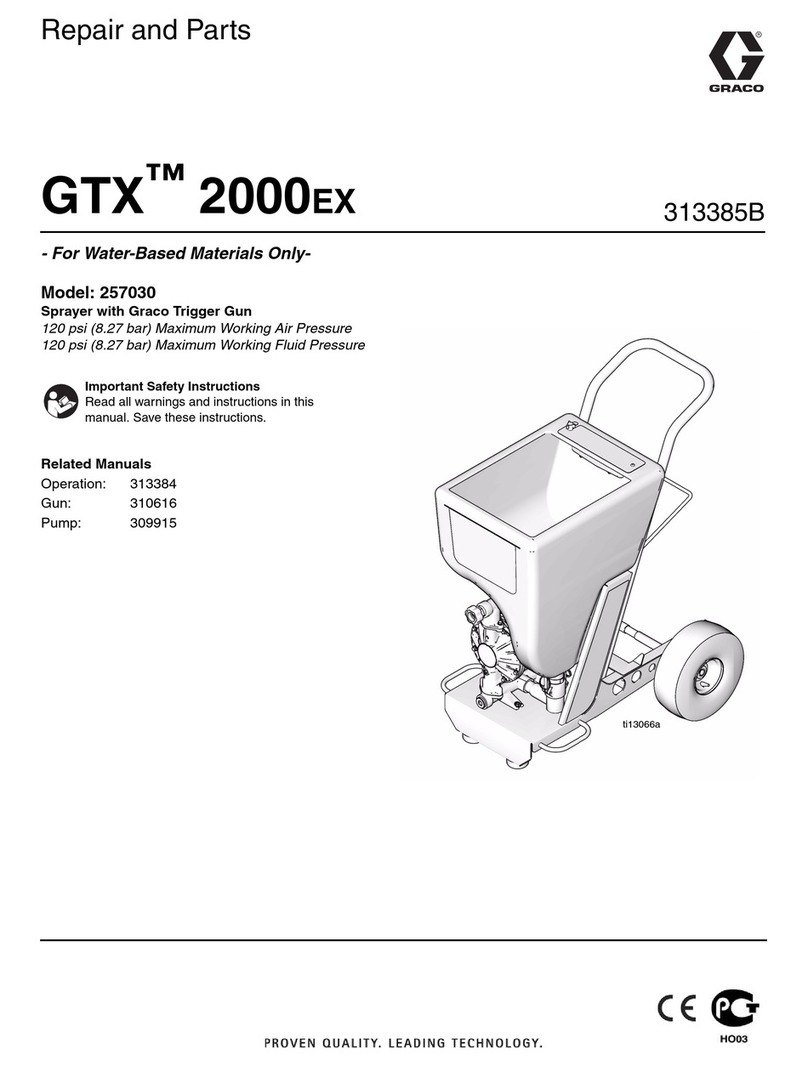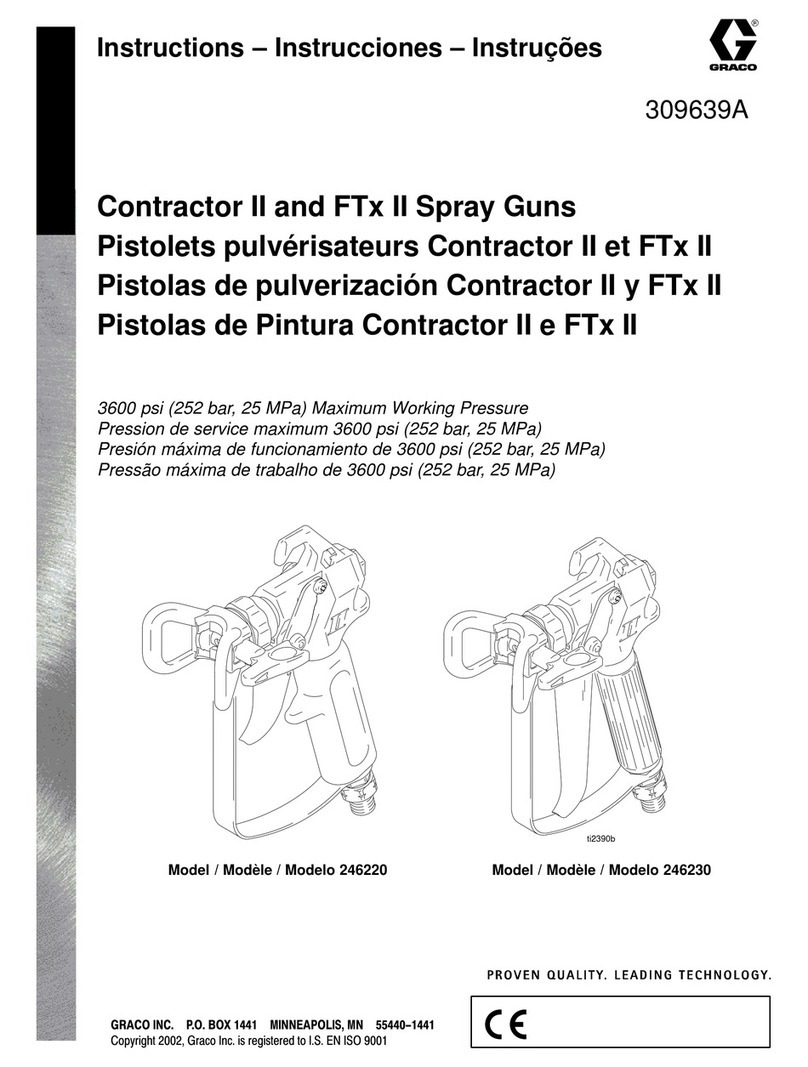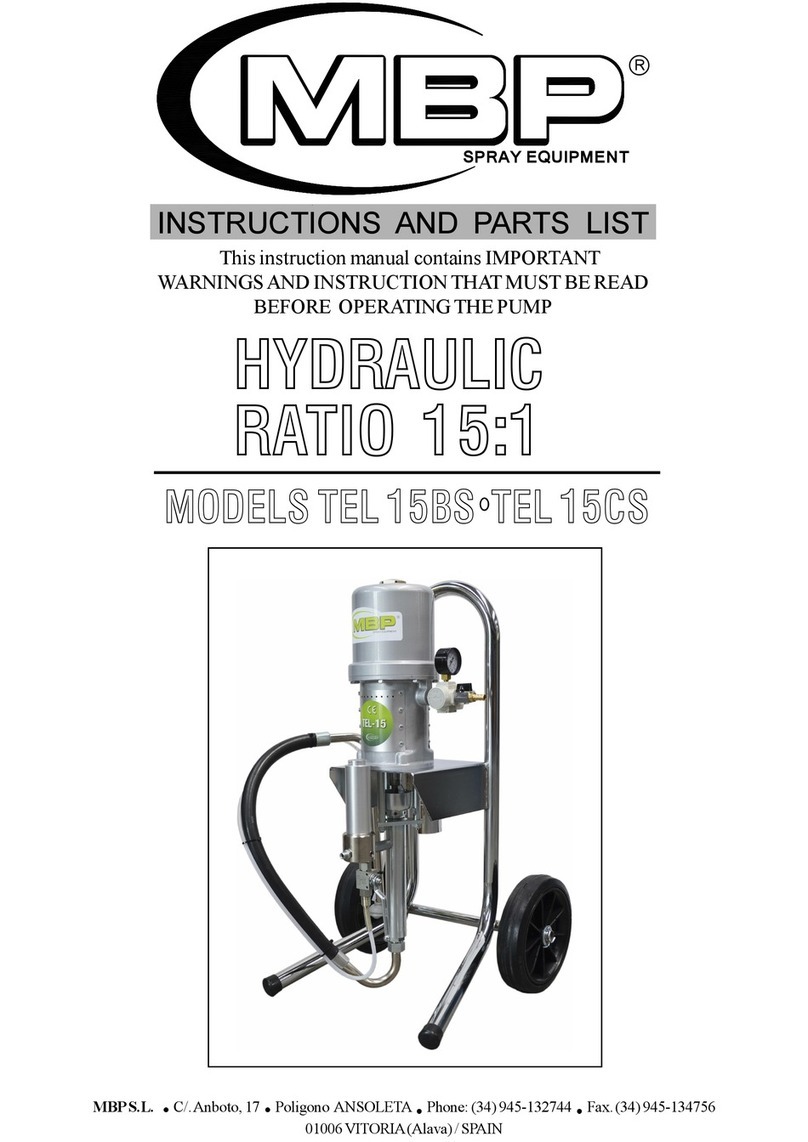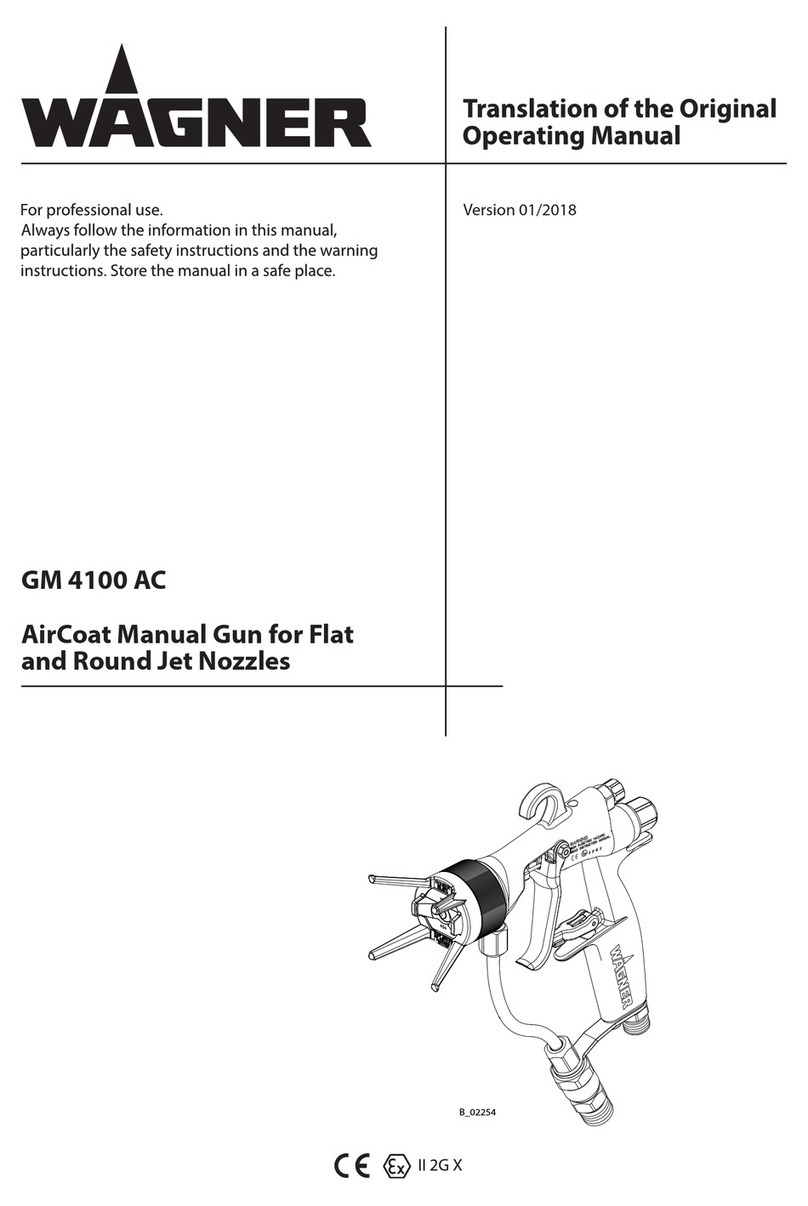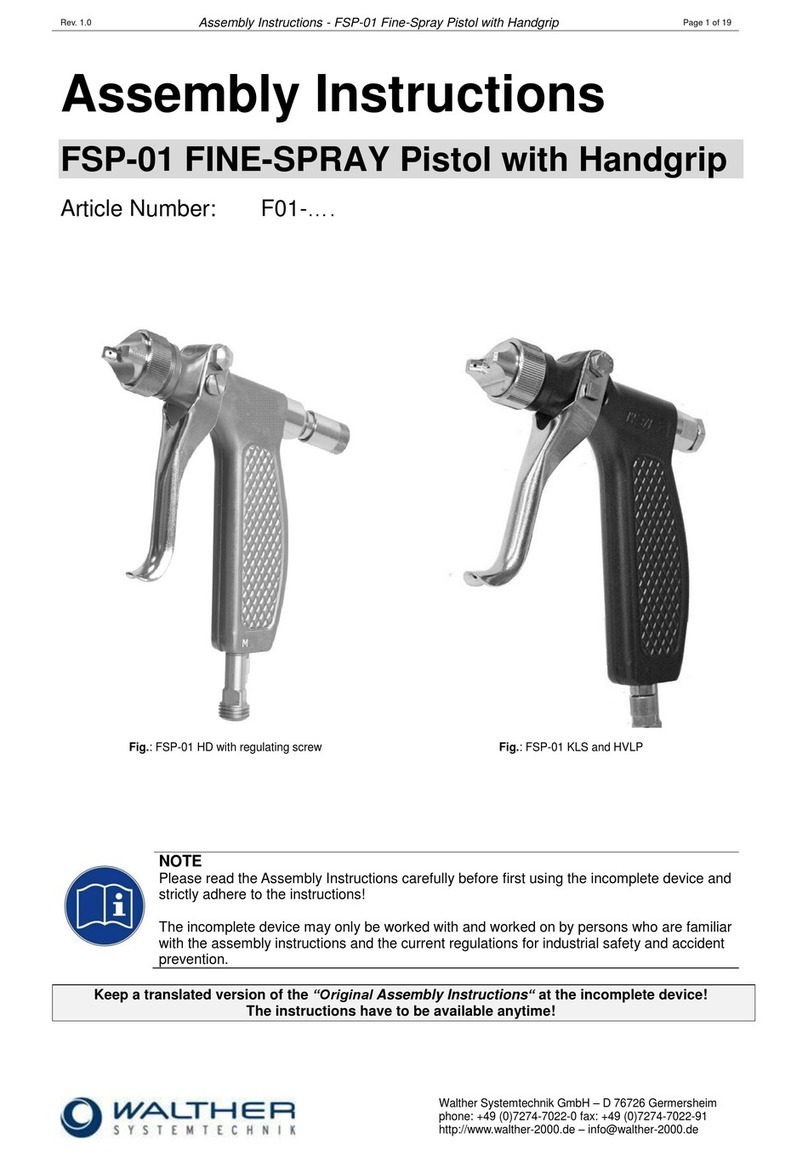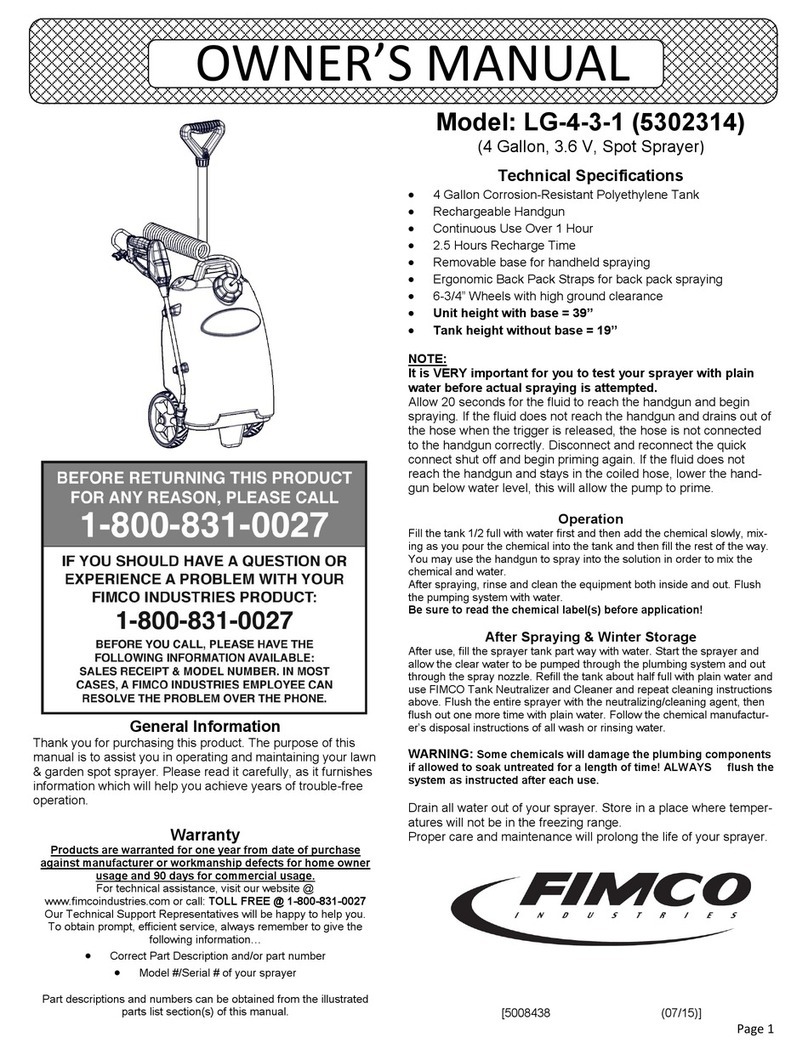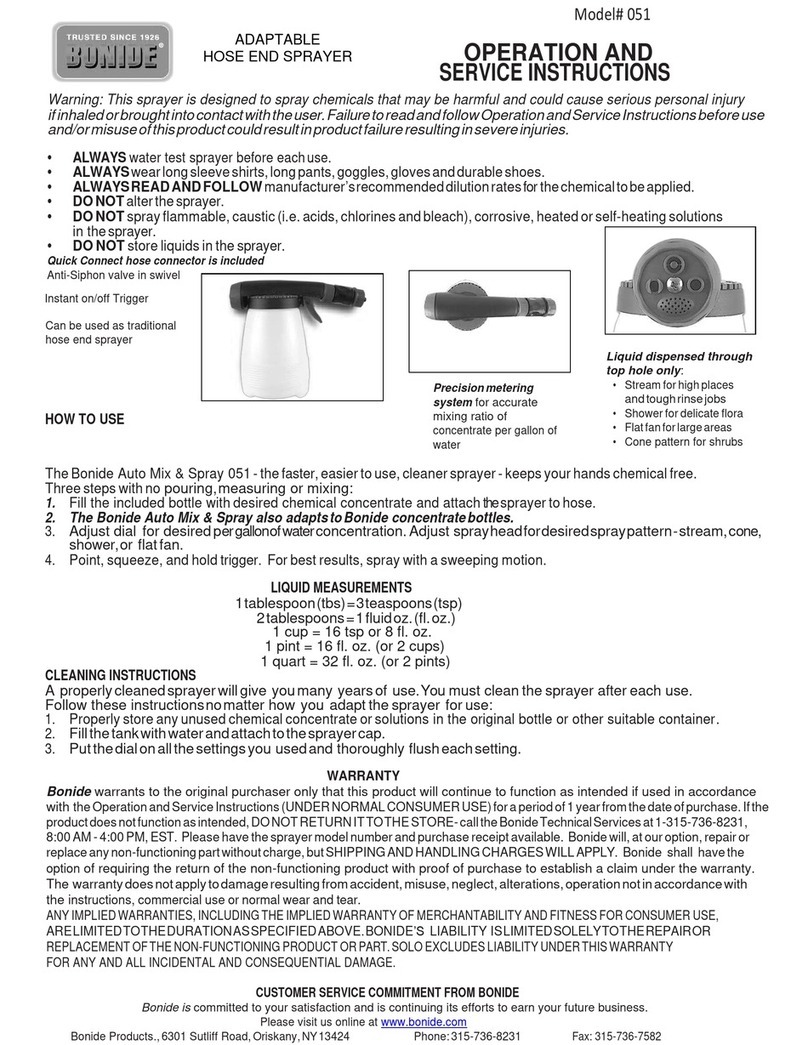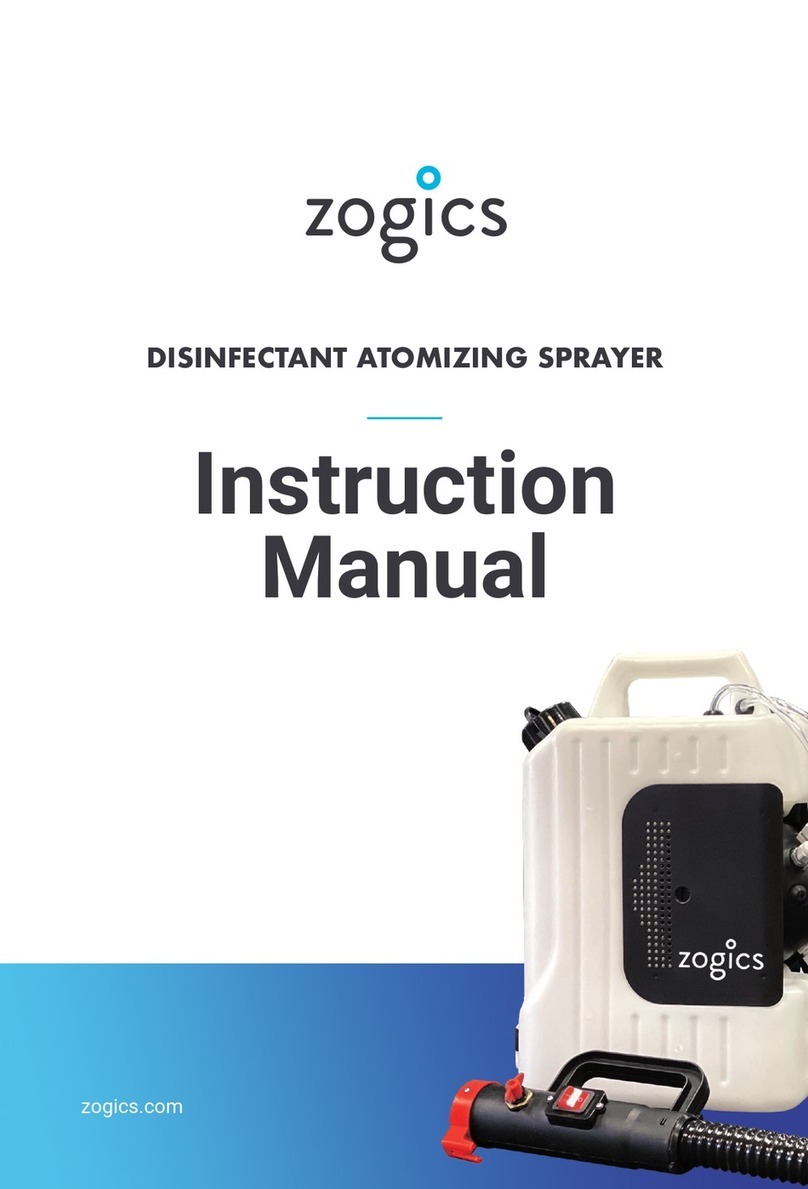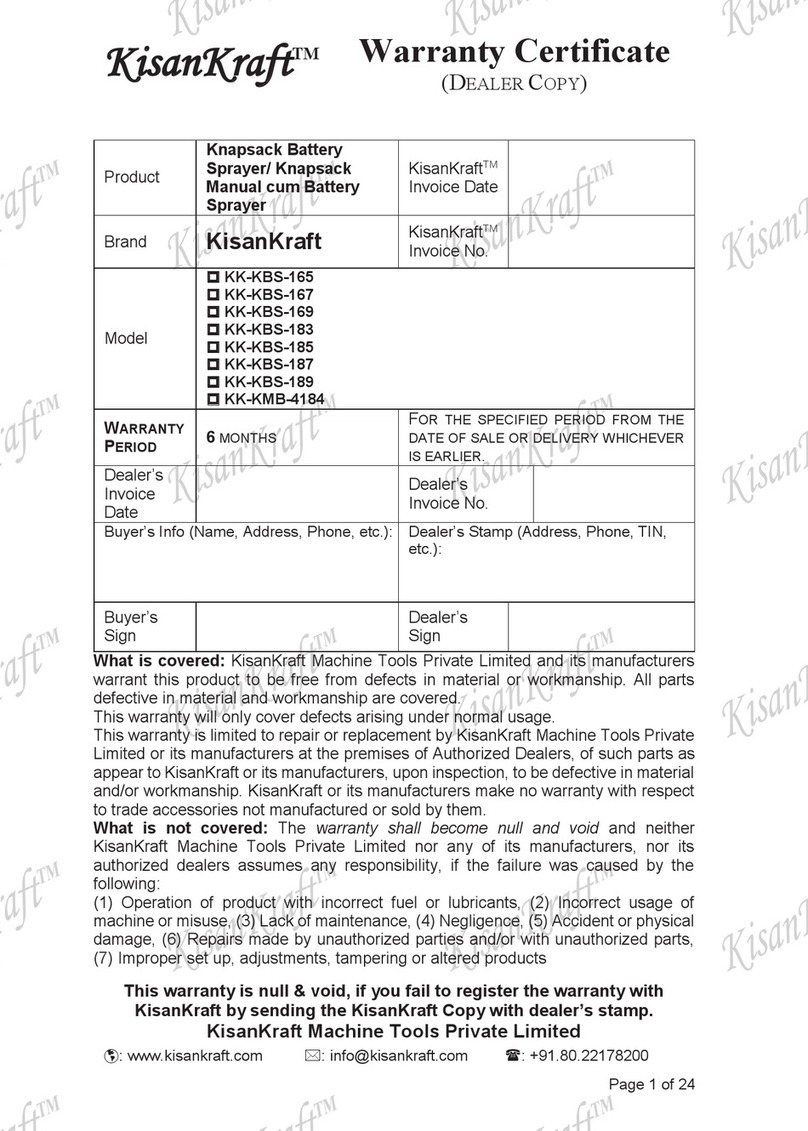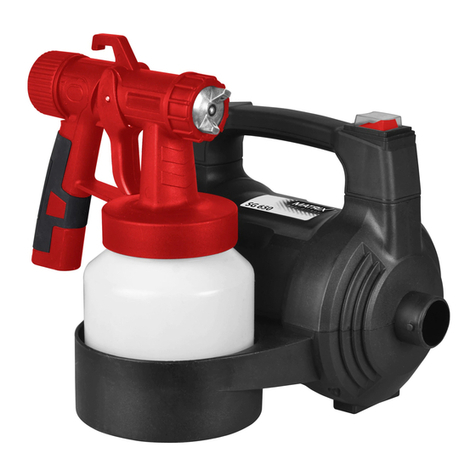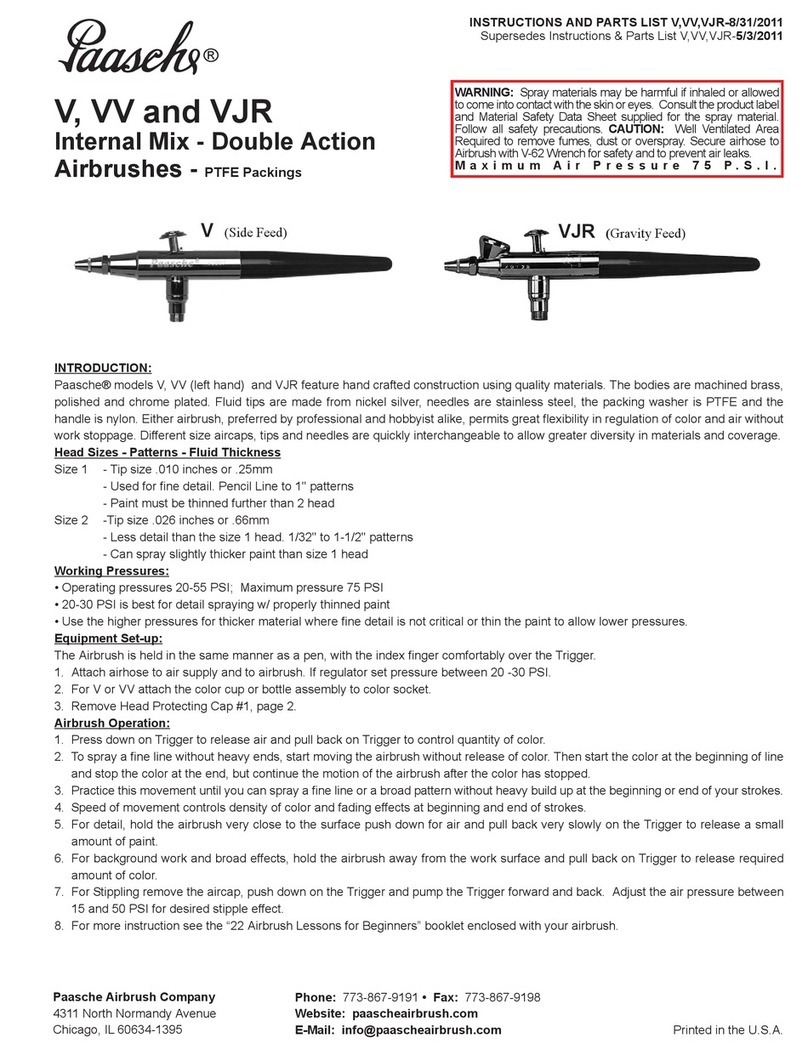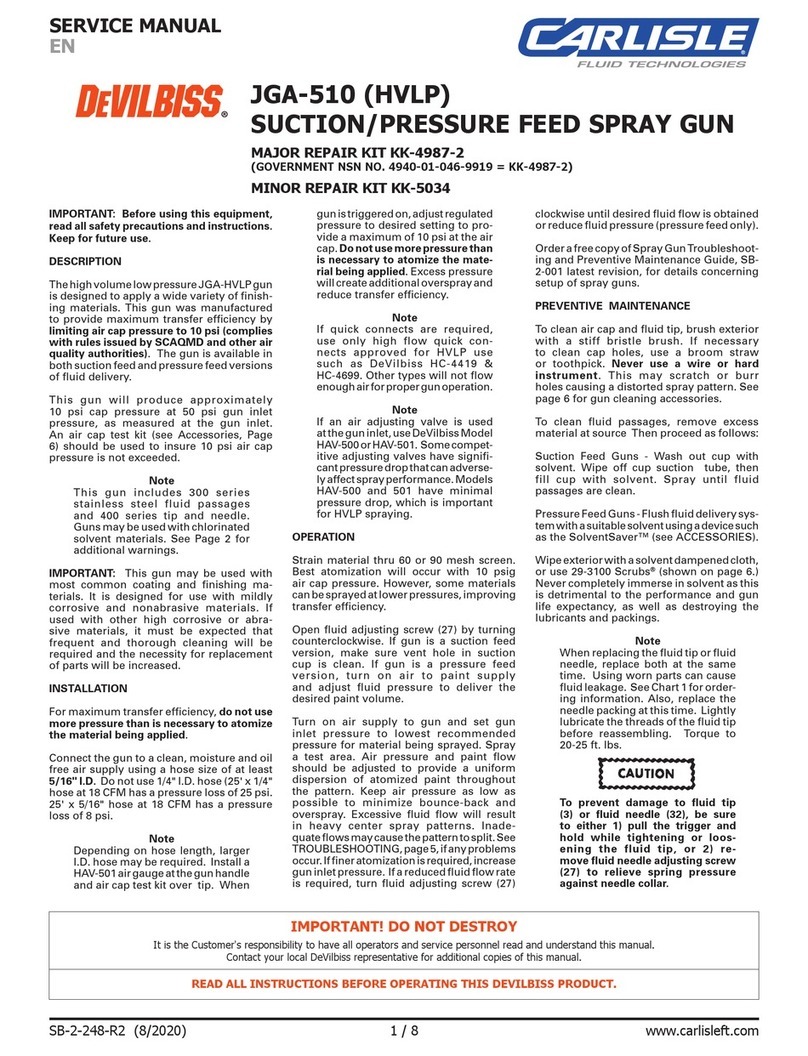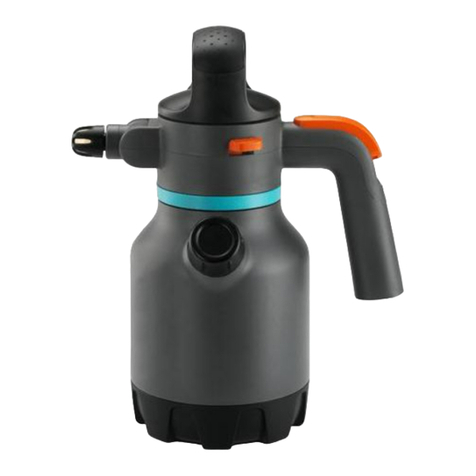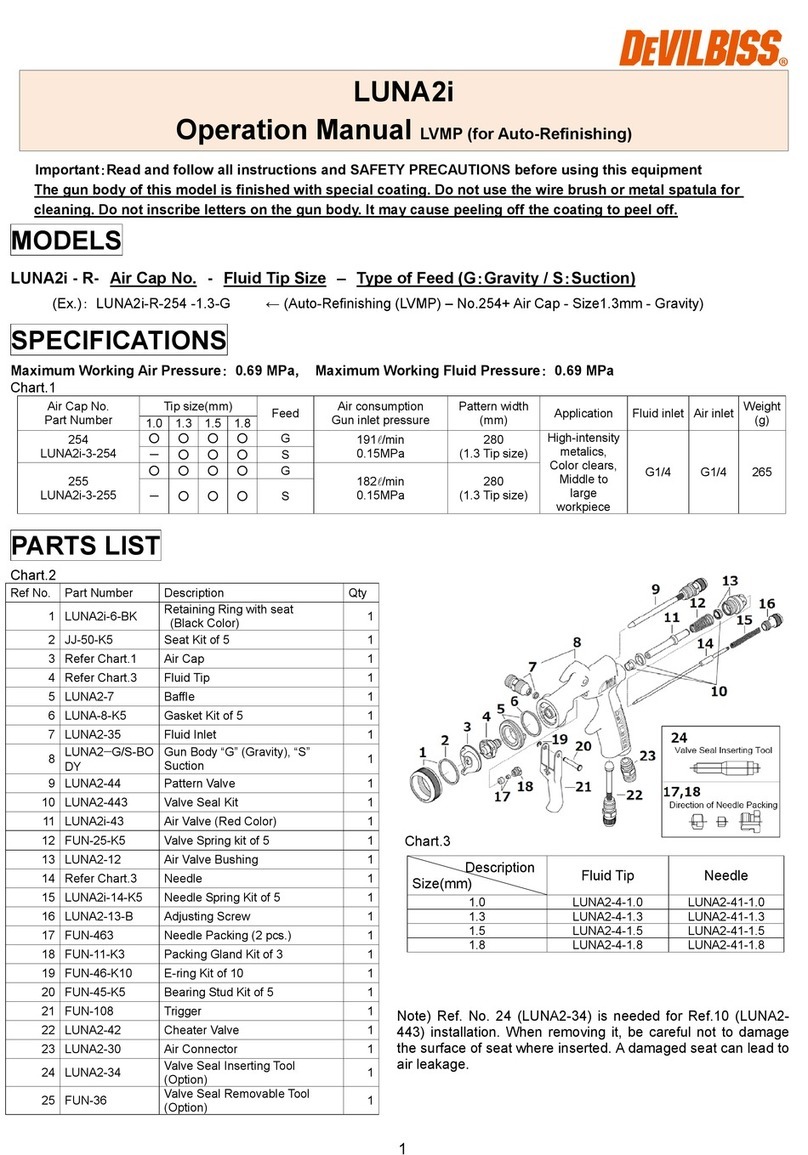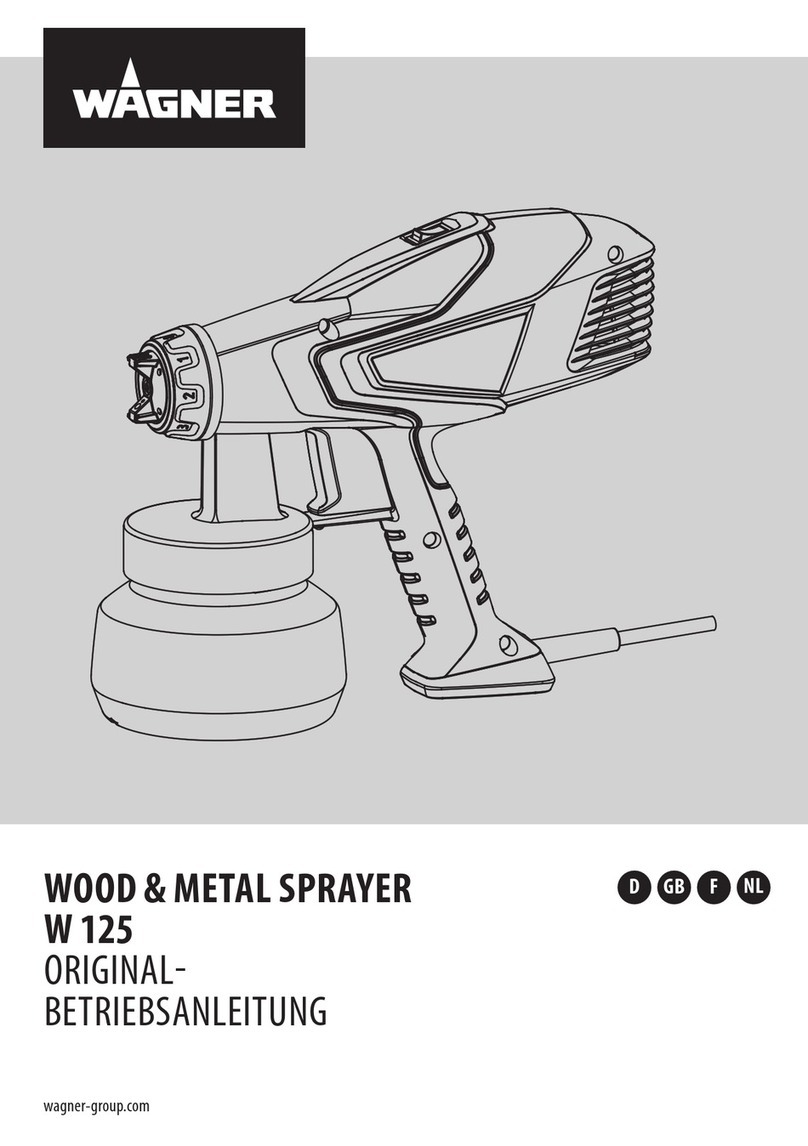
7
307-711
tres
blessures
sérieuses, un incendie, une explosion ou d’autres
dégâts.
NE JAMAIS altére ou modifier une pièce de cet appareil; ceci ris
-
querait
d’entraîner son mauvais fonctionnement.
VERIFIER régulièrement tout l’appareil de pulvérisation et ses
équipements
et réparer ou remplacer immédiatement les pièces
usées
ou abîmées.
Toujours
porter
une protection pour les yeux, de gants, des vête
-
ments
protecteur et un dispositif pour la respiration correspon
-
dant
aux
recommendations des fabricants de fluides et solvants.
Pression
du système
Ce
pulvérisateur peut
produire une
PRESSION MAXIMUM DE
TRAVAIL
de 3000 lb/po.
2
(210 kg/cm
2
).
S’assurer que tous les
éléments
du pulvérisateur et ses accessoires sont conçus pour
résister
à la pression maximum de travail de ce pulvérisateur
.
NE
PAS
dépasser la pression maximum de travail
d’aucun des élé
-
ments
ou accessoires utilisés avec cet appareil.
Compatibilité
chimique des corps
BIEN
S’ASSURER que tous les corps des
solvants utilisés sont
chimiquement
compatibles
avec les parties mouillées indiquées
dans
les “Données techniques”, à la
page 24. T
oujours lire soi
-
gneusement les documents et brochures du fabricant des flui-
des et solvants utilisés avant de s’en servir dans ce pulvérisa-
teur.
MESURES
DE SECURITE CONCERNANT LES TUY
AUX FLEXIBLES
Le
fluide à haute pression circulant dans les tuyaux peut être très
dangereux.
En cas de fuite sur le tuyau, de fissure, déchirure ou
rupture
à la suite de l’usure, de dégâts ou d’une mauvaise utilisa
-
tion,
les projections de fluide haute pression
qui en proviennent
peuvent
entraîner des blessures graves par pénétration sous la
peau
ou par contact, ainsi que des dégâts matériels.
TOUS
LES TUY
AUX FLEXIBLES DOIVENT A
VOIR DES RES
-
SORTS
SPIRALE DE PROTECTION AUX 2 BOUTS!
Les spira
-
les
de protection contribuent à éviter la formation de pliures,
de
boucles
ou de nœuds sur les tuyaux qui pourraient entraîner
la
rupture
du tuyau à l’endroit du raccord ou à son voisinage.
SERRER
FERMEMENT tous les raccords avant chaque utilisa
-
tion.
Le fluide sous pression peut faire sauter un raccord desser
-
ré ou produire un jet à haute pression s’échappant par le rac-
cord.
NE JAMAIS utiliser un tuyau endommagé. Avant chaque
utilisation, vérifier entièrement chaque tuyau pour décler les
coupures, fuites, abrasions, boursouflures de l’enveloppe ou
toute autre détériorations, il faut remplacer le tuyau
immédiatement. NE PAS essayer de refaire le raccord d’un
tuyau haute pression ni de réparer le tuyau avec du ruban
adhésif
ou ou par tout autre moyen. Un tuyau réparé ne peut pas
résister
au fluide sous pression.
MANIPULER
LES TUY
AUX A
VEC PRECAUTION ET CHOISIR
SOIGNEUSEMENT LEUR CHEMIN. Ne pas
déplacer le fluide
en tirant sur le tuyau. Ne pas utiliser de fluides ou de solvants
que
ne sont pas compatibles
avec l’enveloppe intérieur ou exté
-
rieure
de tuyau. NE P
AS exposer le tuyau à fluides des tempéra
-
tures supérieures à 82C (180F) ou inférieures à –40C
(–40F).
Continuité
de la mise à la terre des tuyaux
Une
bonne continuité de la mise à la terre des tuyaux est essen
-
tielle
pour maintenir la mise
à la terre de l’ensemble de vaporisa
-
tion.
Vérifiez la résistance électrique de vos tuyaux à fluides et
à
air
, au moines une fois
par semaine. Si votre tuyau ne compor
-
te
pas d’étiquette qui précise la résistance électrique maximum,
prenez
contact avec le
fournisseur de tuyaux ou la fabricant pour
avoir
les
limites de résistance maximum. Utilisez un mètre de ré
-
sistance
de la gamme appropriée pour votre tuyau et vérifiez la
résistance.
Si celle–ci dépasse les limites recommandées, rem
-
placez
le tuyau immédiatement. Un tuyau sans
mise à la terre ou
avec une mise à la terre incorrecte peut entraîner des risques
pour votre système. Lisez aussi LES RISQUES D’INCENDIE
OU D’EXPLOSION.
RISQUES
D’INCENDIE OU D’EXPLOSION
De l’électricité statique est produite par le passage du fluide à
grande
vitesse dans la pompe et dans
les tuyaux. Si toutes les
pièces de l’appareil de pulvérisation ne sont pas convenable-
ment
reliées ou à la masse ou à
la terre, des étincelles peuvent
se
produire et l’appareil risques d’être
dangereux. Des étincelles
peuvent
Également se produire à l’occasion du branchement ou
du débranchement du cordon d’alimentation ou de l’utilisation
d’un
moteur à essence. Les étincelles sont suf
fisantes pour
allu
-
mer
les vapeurs de solvants et le fluide pulvérisé, les fines parti
-
cules
de poussière ainsi que d’autres substances
inflammables,
quand
on pulvérisé à
l’intérieur ou à l’extérieur
, et elles peuvent
causer un incendie ou une explosion, ainsi que des blessures
graves et des dégâts matériels. Toujour brancher le
pulvérisateur
dans un prise se trouvant à moins 6
m (20 pieds)
de l’appareil et d l’endroit où se fait la pulvérisation. Ne pas
brancher
ou débrancher un cordon d’alimentation quel qu’il soit
dans la zone où se fait la pulvérisateur quand il y a le moindre
risque
que des vapeurs encore
présentes dan l’air prennent feu.
S’il se produit des étincelles d’électricité statique, ou si vous res
-
sentez
la moindre décharge, ARRETEZ IMMEDIA
TEMENT LA
PULVERISATION.
Vérifiez que le système avant que le problème
soit
identifié et corrigé.
Mise
à la terre ou à la masse
Pour réduire les risques de production d’étincelles d’électricité
statique, le pulvérisateur et tous les équipement utilisés ou se
trouvant
dans la
zone de pulvérisation doivent être reliés à la ter
-
re ou à la masse. Pour connaître le détail des instructions de
mise
à la terre dans la région et le
type particulier d’équipement,
CONSULTER le code
ou les réglementations électriques loca
-
les.
S’ASSURER
que tous le équipements de pulvérisation sui
-
vants
sont bien reliés à la terre:
1.
Pulvérisateur:
Brancher le cordon d’alimentation ou la
rallonge
quie doivent être équipés d’une prise 3 fiches en
bon
état, dans une prise de courant convenablement mise à la
terre.
Ne
pas utiliser d’adaptateur
. T
outes le rallonges doivent
avoir
3 files et être prévues pour 15 ampères.
2.
Pistolet:
Réaliser la mise à la terre en le raccordant à une
tuyau
flexible et à
une pulvérisateur déjà convenablement re
-
liés
à la terre.
3.
Tuyaux flexibles:
Afin d’assurer la continuité de la mise à la
terre,
n’utiliser que des
tuyaux comportant une mise à la terre
et ayant une longueur maximum combinée de 150 m (1500
pieds). Se reporter également au paragraphe, “Continuité
du
circuit de mis à la terre des tuyaux”.
4.
Récipient
d’alimentation:
observer le code ou les réglementa
-
tions
locales.
5.
Objets,
matériel ou surfaces recevant
la pulvérisation:
obser
-
ver
le code ou les réglementations locales.
6.
Tous
le seaux de solvant
utilisés pour le rinçage: observer le
code
ou les réglementations locales.
N’utiliser que des seaux
métallique
conducteurs de l’électricité.
Ne pas mettre le seau
sur
une surface non conductrice comme sur du papier ou du
carton
car cela interromprait la continuité de
la mise à la terre.
7.
Pour
conserver la continuité de la mise à la terre quand on rin
-
cé le matériel ou quand on libère
la
pression,
toujours mainte
-
nir
une partie métallique du pistolet fermement appuyée con
-
tre
le côté d’un seau
en métal
puis appuyer sur la détente du
pistolet.
Mesures
de Sécurité concernant le Rinçage
Pour
réduire les risques de blessures par pénétration de la peau
et les risques dûs aux étincelles d’électricité statique ou aux
éclaboussures,
observe la marche à suivre pour le rinçage don
-
née à la page 13 de ce manuel. Observer la“March à Suivre
pour Détendre la Pression” donnée à la page 6 en
enlever
l’ajutage
du pulvérisateur avant le rinçage.
Maintenir une partie
métallique du pistolet fermement appuyée contre le côté d’un
seau
en métal
relié á la terre et utiliser
la pression la plus faible
possible
pendent le rinçage.
